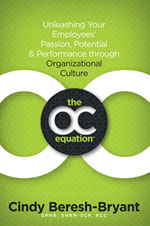 Last week we introduced you to the OC equation. This week we take it a step further to help you understand The Power of Compounding Culture and its impact on establishing your competitive advantage and increasing profitability.
Last week we introduced you to the OC equation. This week we take it a step further to help you understand The Power of Compounding Culture and its impact on establishing your competitive advantage and increasing profitability.
Most of us know the power of compounding interest on our investments (it’s interest calculated on the initial principal and subsequent interest gains from previous periods of time), but did you also know there’s a similar principle known as The Power of Compounding Culture?
The Power of Compounding Culture occurs when you make an emotional investment in your organization and employees where the initial investment begins to feed on itself to either strengthen or degrade your organization. The OC equation is comprised of values, philosophies and actions, creating the outcome and momentum upon which compounding culture multiplies.
Let me explain. Values create the foundation (guiding principles) of your how your organization is run and every decision that’s made. Philosophies and your philosophy statements articulate how the values are expected to come to life and be consistently demonstrated and reinforced throughout the organization. But Actions are where the rubber hits the road. You can have beautifully crafted value and philosophy statements, but if your actions contradict those statements, stakeholders (including your employees) will believe your actions and those actions dictate your culture (good or bad). However, when all 3 are aligned and work together to create a consistent, positive culture where employee and business needs are met, your begin to experience the power of compounding culture and the results are nothing short of extraordinary.
Practical Example
Let’s take 2 very different companies with leaders who ascribe to very different values, philosophies and leadership styles, which are evident in their actions.
- Autocratic Eddie – believes that he is in charge and is responsible for making all the decisions of the department. He believe employees can’t be trusted to make decisions because if you give employees an inch they will take a mile. He also believes employees can’t be trusted and generally come to work late, leave early and steal while. Eddie believes very strict, detailed policies and procedures are required so employees know the rules and can be disciplined for violations.
 Trusting Terry – believes that the best decisions come from involving employees at all levels, especially those directly impacted by the decisions; she believes most employees are both trustworthy and hardworking and they care as much about the company as she does and general guidelines are all that’s needed to manage because 98% of employees act as adults and can be trusted and treated with respect and dignity.
Trusting Terry – believes that the best decisions come from involving employees at all levels, especially those directly impacted by the decisions; she believes most employees are both trustworthy and hardworking and they care as much about the company as she does and general guidelines are all that’s needed to manage because 98% of employees act as adults and can be trusted and treated with respect and dignity.
Because of Autocratic Eddie’s perspective, when new employees start work, he immediately tells them they are on a 90-day probationary period and their ability, attitude, and attendance will be measured before a final decision is made on their future employment status. In addition, he requires his employees to punch a time clock and when absences occur they’re docked pay and each absence is carefully tracked and monitored. Autocratic Eddie’s employees are required to work the day before and after holidays so they don’t arbitrarily become “sick” to extend a holiday weekend.
Trusting Terry, on the other hand, has no such discussion with her employees regarding a a probationary period . She considers them full-fledged team members from day one and expects them to immediately contribute to the success of the organization. Her employees don’t punch a time clock, they record their time on time sheets that are turned in at the end of each week. When employees need to be absent from work she trusts them to record that on their time sheet so the company has accurate payroll records. Employees with habitual absences are coached individually for improvement and she has never mentioned to her employees that they need to work the day before and after a holiday, but come to think of it, she’s never had a reason to.
As you read these two very realistic examples, you can begin to see the power of compounding culture. In Autocratic Eddie’s environment, it is likely that with each passing day, he gets less and less from his employees and the results of compounding culture spiral downward. Employees become unmotivated clock watchers who do just enough to get by because that’s all that’s expected. Employees give no more effort to Eddie and the organization than Eddie gives them. This negative culture compounds and begins to erode the engagement, morale, motivation and ultimately the profitability of both current and future employees. Good employees begin to leave the organization to find a strong positive culture where their needs are met and they are trusted and appreciated while talented candidates avoid interviewing or decline offers because no one wants to work in a toxic environment.
Trusting Terry has a very different experience. She develops relationships with her employees and gets to know them. She demonstrates genuine concern for them as individuals and as a team. She engages employees in decisions that affect them and seeks their input. In other words, she trusts her employees and treats them with respect and dignity and they do the same in return. The idea of giving a little bit more is mutual and based on trust and respect. Rather than writing policies for the 2% that will abuse them, policies are written for the 98% who do it right. This culture is one of respect, dignity and trust within and between all employees which results in strong compounding dividends where good employees will go to the mat for her because they know she will do the same for them. In Terry’s organization, performance and profits soar. Current employees are engaged and invested in this work environment and rarely leave and that just continues to attract more good employees continuing the compounding effect.
What’s compounding in your organization? Is it good or bad? What are the outcomes of your compounding culture?



